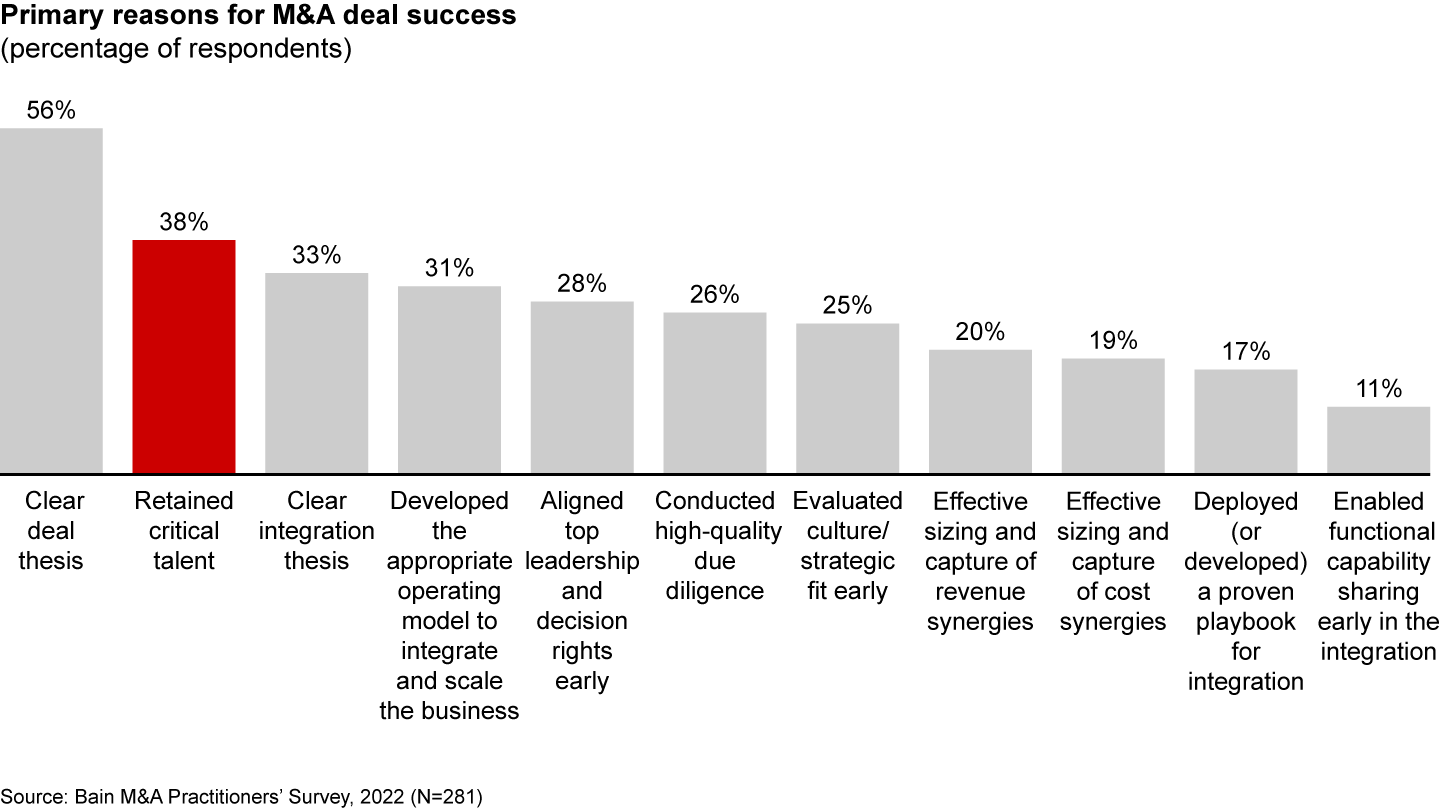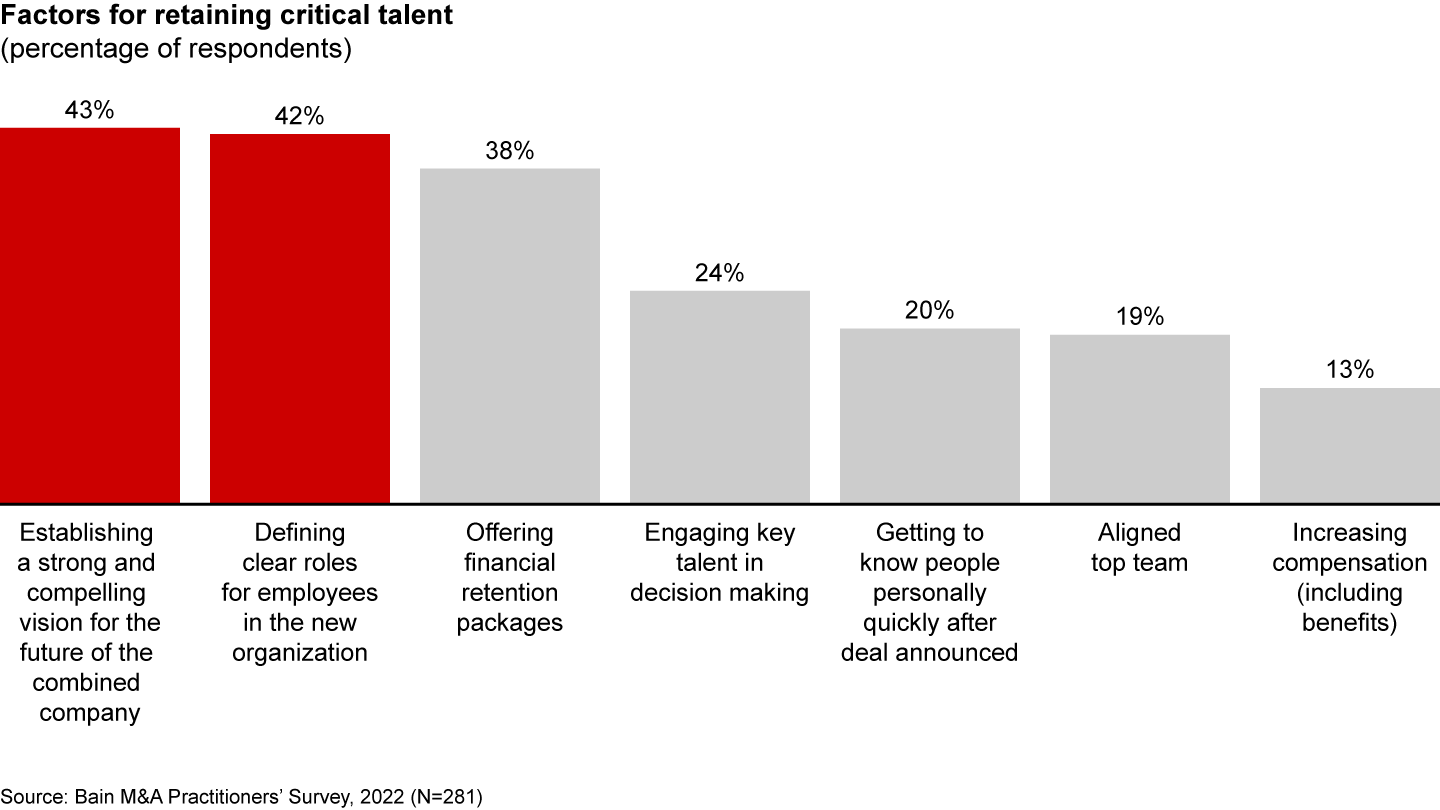M&A Report
 }
}
At a Glance
- Executives see talent retention as the second-biggest contributor to deal success. And with record numbers of employees actively job searching, the challenge is getting even more critical as many industries face a talent shortage.
- The best companies take critical steps in both the diligence and integration stages to ensure that talent stays put. For example, they invest to understand a target’s centers of influence and perform extensive diligence pre-close to assess attrition risks and employee engagement.
- Executives who successfully retain key talent through integration say that establishing a strong and compelling vision for the future is the most important element contributing to that success.
This article is part of Bain's 2022 M&A Report.
Even in the best of times, mergers and acquisitions cause employees to worry about uncertainty and change, often leading them to consider other options. But these are not the best of times. Virtually no company has been unaffected by the Great Resignation as record numbers of employees explore new opportunities.
A March 2021 Gallup poll found that 48% of the US working population was actively job searching or watching for opportunities. It was a survey that included workers in every job category, from hourly consumer-facing roles to highly paid professionals. According to the US Department of Labor, more than 4.5 million workers quit their jobs voluntarily in November, the most in the two decades in which the government has been keeping track.
Some companies are doing a better job than others of proactively addressing people issues throughout the diligence and integration processes.
These are stats that haunt any proposed talent-focused deal: People were already thinking of leaving, and a pending acquisition or merger can make that decision even easier. Our survey of executives found that talent retention is the second-biggest contributor to deal success (see Figure 1). When talent is a major factor in a potential deal, acquirers need to proactively address people issues throughout the diligence and integration processes. Some companies are doing a better job of this than others.

Reimagine your people due diligence
While most executives acknowledge that people issues are critical in an integration, they often examine only a few areas during the diligence process. They tend to focus primarily on the executive leadership team; they also typically explore a limited set of solutions, such as compensation packages for senior leaders. Acquirers that are surfacing as winners, however, take a robust and creative approach to people diligence when exploring a target. This approach gives them visibility into the team and culture that has propelled the target’s success and can inform decisions about whether to pursue the deal and how to shape an eventual integration.
It starts by understanding a target company’s centers of influence. That means quickly identifying key players across three categories:
- Who is mission critical today? Who drives the day-to-day success as a result of their expertise, and who is critical in the near-term to ensuring continued performance and supporting the integration?
- Who is mission critical tomorrow? Who can deliver the capability spikes needed to achieve full potential?
- Who are the true people influencers? Who do people listen to, and who will likely take others with them if they leave?
Acquirers need to ask pointed questions to build an initial list of critical talent, outlining their roles and responsibilities and specifics on how they are critical to the success of the company. Leaders should quickly craft a strawman of the combined company’s future operating model, working to answer two basic questions:
- How different is it from the way they work today?
- What level of change and disruption do they anticipate for the key players?
Acquirers need to ask pointed questions to build an initial list of critical talent, outlining their roles and responsibilities and specifics on how they are critical to the success of the company.
It’s important to keep a close eye on impacted populations that are both critical to future success and that are likely to undergo a significant change. Invest heavily in these individuals. As soon as possible, cultivate direct relationships with them to understand their aspirations, motivations, and career goals. Financial incentives keep people in the short term, but nonfinancial considerations around purpose, growth and development, and cultural connectivity keep them for the long term. Actively build a point of view on their likelihood to stay and potential drivers for retention, and build it into your plans from day one. It’s essential to ensure that acquisitions are aligned with longer-term talent strategies—including building the new capabilities that can drive growth; unlock new adjacencies; and support diversity, equity, and inclusion efforts.
Video: Bain Partner Sinead Mullen discusses ways for M&A executives to manage the widening talent gap and address people issues throughout the entire deal process.
Get creative about how to read the landscape
Too many executives underinvest in people diligence simply because they don’t believe they can access meaningful information until after close. Yet the best talent acquirers find ways to be proactive pre-close to determine the potential risks and accelerate the integration journey from day one. These are the steps that matter.
Get the conversation started. Don’t shy away from engaging key talent. Ask to speak with a broader group of people, not just the executive team. In addition to those conversations, reach out to alumni—they may be willing to speak more openly than current employees. Remember that different sources are biased in different ways, so you need a balance of perspectives. These conversations can give you significant insights into talent, existing strengths and weaknesses, perceptions of your company, level of attrition risk, and hidden assets within the organization.
Leverage publicly available data. Digital tools can help bring visibility into a target’s historical attrition rates or engagement metrics during diligence. Together, they can paint an accurate picture of the employee dynamics within the company. Glassdoor offers preliminary insights into employee sentiment, allowing you to anticipate attrition risk, change fatigue, or burnout in the target company. LinkedIn provides visibility into the organization, helping you understand the current operating model and depth of capabilities. Fishbowl includes open conversations from employees, providing insight into how the community interacts.

Five Big Things to Know about M&A in 2022
Retaining talent, capturing revenue synergies, boosting ESG, and making the most of alternative deal models are top of mind for buyers.
Use people insights to guide the integration
The people diligence should inform whether you do the deal. If that diligence raises too many red flags, don’t hesitate to walk away. But if the people and culture issues seem manageable, the diligence should dictate how you approach integration. As soon as you mobilize for integration, translate people diligence learnings into implications for the integration. Two best practices ensure that you are engaging on people issues right from the start.
Cocreate a clear, compelling vision for the combined company. Executives who successfully retain key talent through the integration say that establishing a strong and compelling vision for the future is the No. 1 most important element (see Figure 2). Immediately after closing a deal, bring leaders and influencers together to craft that vision for the future organization. This narrative should include a case for change, a view of the future state, measures of success, and guiding principles—the guardrails for making key decisions. The simple act of imagining and defining a shared future so soon after close helps to align leaders, build excitement, and foster energy for the change ahead.

In the merger that created UKG, leaders from Kronos and Ultimate Software came together to shape the story of their future, clarifying their shared purpose and highlighting the opportunity to make even more impact as a combined entity. This process aligned leaders around a shared aspiration to truly put people at the center of their business. The process also alleviated concerns around cultural differences and distinctive ways of working.
Build energy from the middle. Tons of great talent sits below the executive level. Reach out to those key leaders and critical influencers, and directly engage them in the process, enlisting them as integration ambassadors. This team can provide feedback on the integration journey, identify and help solve emerging issues, and build cultural understanding and connectivity across legacy organizations. This group can help protect the blind spots of the executive team and integration leaders. They see, hear, and experience the integration (and the business) differently, and they can pinpoint risks, opportunity areas, and emerging challenges.
Such a team played a key role in accelerating the cultural integration of Caliber and Abra, supporting the rollout of store conversion and other key changes. By inviting these individuals into the process, the leadership team empowered key influencers to proactively support and shape the change journey while building advocacy within the organization.
Understand the organizations’ capacity for change. The ability to navigate change through an integration is a key determinant of value in most deals. Many leaders pay limited attention, however, to change readiness—that is, an organization’s capacity to effectively navigate change. Bain’s Change Power Index® tool helps companies anticipate the change archetype of both their own company and that of the target. It serves as a starting point for planning for remedies and solutions. Clearly understanding each organization’s ability to change can help determine how to structure an integration in a way to support your talent strategy and accelerate value capture while mitigating risk.
The popularity of using M&A to obtain and retain scarce talent has introduced a new term into the business lexicon: the “acqui-hire.” As the talent gap threatens growth and profits across industries, more companies will devote more energy to performing creative people diligence and enabling people insights to guide integration. How to predict the winners in the raging war for skills? They’re the companies with an unwavering focus on talent before, during, and after the deal—deal after deal.


